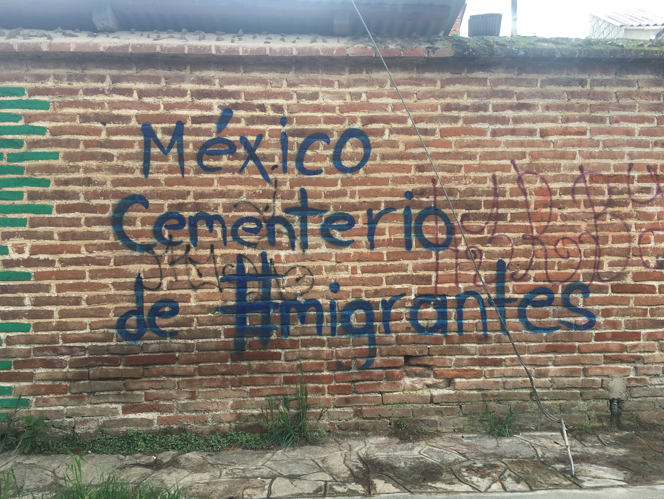Dispatches From Mexico’s Southern Border: Mexico: A Migrant Graveyard
This is the third in a series of four "Dispatches From Mexico’s Southern Border." Read parts one, two, and four.
“Five over there. Five over there. Ten up ahead. Nineteen beyond that.”

Published by The Lawfare Institute
in Cooperation With

This is the third in a series of four "Dispatches From Mexico’s Southern Border." Read parts one, two, and four.
“Five over there. Five over there. Ten up ahead. Nineteen beyond that.”
It’s a sticky hot day in Tapachula, Chiapas, and sweat beads roll down the caretaker’s forehead as he points to piles of dirt lining the sandy walkway of the Panteón Jardín graveyard. Each mound of fresh dirt marks a grave full of unidentified bodies stuffed in white bags. Most of them are men, many of them indocumentados.
I stopped by the graveyard to see the final resting place of some of the nameless migrants who spent their last days along this part of the border. It’s likely that some were members of the Mara Salvatrucha (MS-13) and Barrio 18 gangs that are prevalent in this area, some were fleeing these gang members and some had nothing to do with the gangs. Others are identified in the local news only by the places and positions where their lifeless bodies were found. This is the case with the most recent arrival, a woman, thought to be 35 to 40 years old, listed only as: “found lying face up on the dirt floor of a home.”
These unmarked mounds stretch the length of the graveyard—the final resting places of people who are as invisible in death as they often were in life. I observed these graves and more last month during a two-week trip along Mexico’s 700-mile southern border. While international attention has focused on the U.S.-Mexico border in recent weeks, I traveled further south in hopes of documenting the dynamics along Mexico’s southern border and the conditions in which Central American migrants travel north.
Migrants who arrive to Tapachula are following the most well-trodden migratory paths in Mexico. They join people from around the world who have come to this city, now home to 320,000, for the past 200 years. In the 1800s and early 1900s, the foreigners were German, Chinese, Japanese, French, British, Spanish and American. Today, these historic routes are trod by Central Americans, along with migrants from India, Bangladesh, Nepal, Cameroon, Eritrea and beyond.
These travelers cross into Mexico only 25 miles away through the Suchiate river border, floating across on rafts or wading upstream through the current. Some migrants arrive after only a few hours of travel from their Guatemalan towns, while others have traversed the length of South and Central America in their bid to head north. In Tapachula, the routes converge briefly as some migrants move straight through the city and others seek out the local shelters before pressing on or immediately apply for refugee status; Tapachula is home to one of the three fully functioning offices for the Comisión Mexicana de Ayuda a Refugiados (COMAR), the only agency in Mexico that can process refugee status claims.
Once they’re in Tapachula, the migrants have made it to Mexico, but that doesn’t mean they are safe. For the majority of migrants, especially those continuing north, the real dangers are just beginning.
Mexico is notoriously treacherous for migrants, and the Tapachula route has specific dangers. Decades of immigration enforcement historically pushed a subpopulation of migrants traveling to the United States to the fringes of Mexico’s transportation system, with tens of thousands of migrants riding atop the country’s freight trains. These trains and the hardships their riders endured became the face of migration through Mexico. And the crimes that ensued along the way captured headlines in Mexico and beyond, with reports of gangs boarding trains to charge the riders a fee, criminal groups kidnapping migrants off trains at gunpoint, and migrants banding together to support one another against such threats.
Today, fewer migrants take the trains. But even getting to the trains from Tapachula means navigating migration checkpoints along Mexico’s northbound highways to the trains’ first stop, in Arriaga. This means hiking around the highway checkpoints on remote paths, exposed to both the elements and the opportunistic criminals who lie in wait. While many of these criminals are locals, they also include the same gangs that many Central Americans are fleeing: Mara Salvatrucha (MS-13) and Barrio 18. These gangs monitor the flows of migrants; attempt to infiltrate migrant shelters to identify future victims; and they rob, sexually assault and extort migrants for the right to continue their journeys.
Farther north, a host of other criminal groups wait to extort migrants. Along the U.S.-Mexico border in the northern states of Sonora or Tamaulipas, migrants must pay a fee to pass through the border areas, with non-compliance punishable by kidnapping or death. According to a database of 388 migrant kidnapping cases in Mexico from 2006 to 2018 (collected with my Strauss Center colleague Caitlyn Yates), the U.S.-Mexico border city of Reynosa registered the most migrant kidnappings. In these cases, migrants were often intercepted and taken off buses, and their families received a phone call ordering them to pay $3,000 to $5,000 U.S. for their relative’s release. While it is impossible to be certain, these migrants likely include some of those who did not pay fees to the criminal groups in the first place.
Each crime has its own characteristics, but overall similarities are apparent. In just the southern border state of Chiapas, 134 migrants were murdered from 2012 to 2017, according to state records, and 280 other deaths in that time were recorded as “manslaughter.” This puts the state average at 69 violent migrant deaths per year—and these are only the cases reported to the Chiapas government. This figure does not cover the others who died without any identification or travel companions who would identify them as a foreigner. There are very few convictions for crimes against migrants in Mexico, with the Washington Office on Latin America noting a 99 percent impunity rate.
This human cost of migration brings universal condemnation. But the lack of legal consequences or other substantive reactions suggests an implicit acceptance of these violent taxes on irregular movement. Migrants are at higher risk for crimes and environmental dangers when governments prioritize enforcement without sufficiently addressing the root causes driving efforts to relocate. It shouldn’t be surprising that when governments do nothing to fulfill people’s dreams of safety, opportunity or family reunification; fail to provide legal pathways for achieving these dreams; and crank up enforcement against people trying to fulfill them anyway, the paths that that they take only become increasingly dangerous.
To the south of where so much U.S. and international attention has focused on border crossings, tens of thousands of migrants continue crossing through Mexico despite the exploitation and criminal activities that they routinely face. As they slip through Mexican communities, both the migrants and the crimes against them are treated like an invisible blight. “Mexico is a migrant graveyard,” reads a graffiti-covered wall on a back road in San Cristobal de las Casas in Chiapas. Yes, one giant 32-state graveyard full of unmarked graves.



.jpg?sfvrsn=676ddf0d_7)

